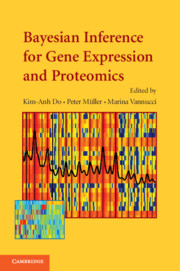Book contents
- Frontmatter
- Contents
- List of Contributors
- Preface
- 1 An Introduction to High-Throughput Bioinformatics Data
- 2 Hierarchical Mixture Models for Expression Profiles
- 3 Bayesian Hierarchical Models for Inference in Microarray Data
- 4 Bayesian Process-Based Modeling of Two-Channel Microarray Experiments: Estimating Absolute mRNA Concentrations
- 5 Identification of Biomarkers in Classification and Clustering of High-Throughput Data
- 6 Modeling Nonlinear Gene Interactions Using Bayesian MARS
- 7 Models for Probability of Under- and Overexpression: The POE Scale
- 8 Sparse Statistical Modelling in Gene Expression Genomics
- 9 Bayesian Analysis of Cell Cycle Gene Expression Data
- 10 Model-Based Clustering for Expression Data via a Dirichlet Process Mixture Model
- 11 Interval Mapping for Expression Quantitative Trait Loci
- 12 Bayesian Mixture Models for Gene Expression and Protein Profiles
- 13 Shrinkage Estimation for SAGE Data Using a Mixture Dirichlet Prior
- 14 Analysis of Mass Spectrometry Data Using Bayesian Wavelet-Based Functional Mixed Models
- 15 Nonparametric Models for Proteomic Peak Identification and Quantification
- 16 Bayesian Modeling and Inference for Sequence Motif Discovery
- 17 Identification of DNA Regulatory Motifs and Regulators by Integrating Gene Expression and Sequence Data
- 18 A Misclassification Model for Inferring Transcriptional Regulatory Networks
- 19 Estimating Cellular Signaling from Transcription Data
- 20 Computational Methods for Learning Bayesian Networks from High-Throughput Biological Data
- 21 Bayesian Networks and Informative Priors: Transcriptional Regulatory Network Models
- 22 Sample Size Choice for Microarray Experiments
- Plate section
17 - Identification of DNA Regulatory Motifs and Regulators by Integrating Gene Expression and Sequence Data
Published online by Cambridge University Press: 23 November 2009
- Frontmatter
- Contents
- List of Contributors
- Preface
- 1 An Introduction to High-Throughput Bioinformatics Data
- 2 Hierarchical Mixture Models for Expression Profiles
- 3 Bayesian Hierarchical Models for Inference in Microarray Data
- 4 Bayesian Process-Based Modeling of Two-Channel Microarray Experiments: Estimating Absolute mRNA Concentrations
- 5 Identification of Biomarkers in Classification and Clustering of High-Throughput Data
- 6 Modeling Nonlinear Gene Interactions Using Bayesian MARS
- 7 Models for Probability of Under- and Overexpression: The POE Scale
- 8 Sparse Statistical Modelling in Gene Expression Genomics
- 9 Bayesian Analysis of Cell Cycle Gene Expression Data
- 10 Model-Based Clustering for Expression Data via a Dirichlet Process Mixture Model
- 11 Interval Mapping for Expression Quantitative Trait Loci
- 12 Bayesian Mixture Models for Gene Expression and Protein Profiles
- 13 Shrinkage Estimation for SAGE Data Using a Mixture Dirichlet Prior
- 14 Analysis of Mass Spectrometry Data Using Bayesian Wavelet-Based Functional Mixed Models
- 15 Nonparametric Models for Proteomic Peak Identification and Quantification
- 16 Bayesian Modeling and Inference for Sequence Motif Discovery
- 17 Identification of DNA Regulatory Motifs and Regulators by Integrating Gene Expression and Sequence Data
- 18 A Misclassification Model for Inferring Transcriptional Regulatory Networks
- 19 Estimating Cellular Signaling from Transcription Data
- 20 Computational Methods for Learning Bayesian Networks from High-Throughput Biological Data
- 21 Bayesian Networks and Informative Priors: Transcriptional Regulatory Network Models
- 22 Sample Size Choice for Microarray Experiments
- Plate section
Summary
Abstract
We discuss methods to identify DNA regulatory elements by exploiting the correlation between sequence data and gene expression. We start by reviewing the contribution of M. G. Tadesse et al. (Identification ofDNAregulatory motifs using Bayesian variable selection. Bioinformatics, 20 (2005), 2553–2561) in the use of Bayesian methods for variable selection for the identification of binding sites for regulatory factors. We then propose an extension of their model to include gene regulators. Although the modeling frameworks for variable selection has been extensively studied in the literature, their application in genomic studies for the identification of regulatory elements represents a novel contribution. We report performances of the methodologies on the well-studied regulatory systems of Saccharomyces cerevisiae under heat shock.
Introduction
The study of gene regulation plays an important role in understanding gene expression. A biological understanding of this complicated process motivates the techniques for analyzing and modeling gene expression and gene regulation. Fundamental principles of genetics are transcription (the process of encoding information in DNA as mRNA) and translation (the process of making proteins from mRNA). Microarrays measure the abundance of mRNA and, thus, describe gene expression at the transcription level. Understanding how transcription is regulated in the cell can provide insights into developing rich models for analyzing microarrays.
The mechanisms that control gene transcriptions consist of many different classes of proteins and classes of DNA sequences [10]. The proteins involved, known as trans-acting factors or transcription factors, interact with control points of DNA sequences known as cis-acting regulatory sequences. In eukaryotic systems, such as human cells and yeast, RNA polymerase II is solely responsible for transcribing DNA to mRNA. This polymerase requires multiple sets of cis-acting regulatory sequences.
- Type
- Chapter
- Information
- Bayesian Inference for Gene Expression and Proteomics , pp. 333 - 346Publisher: Cambridge University PressPrint publication year: 2006

